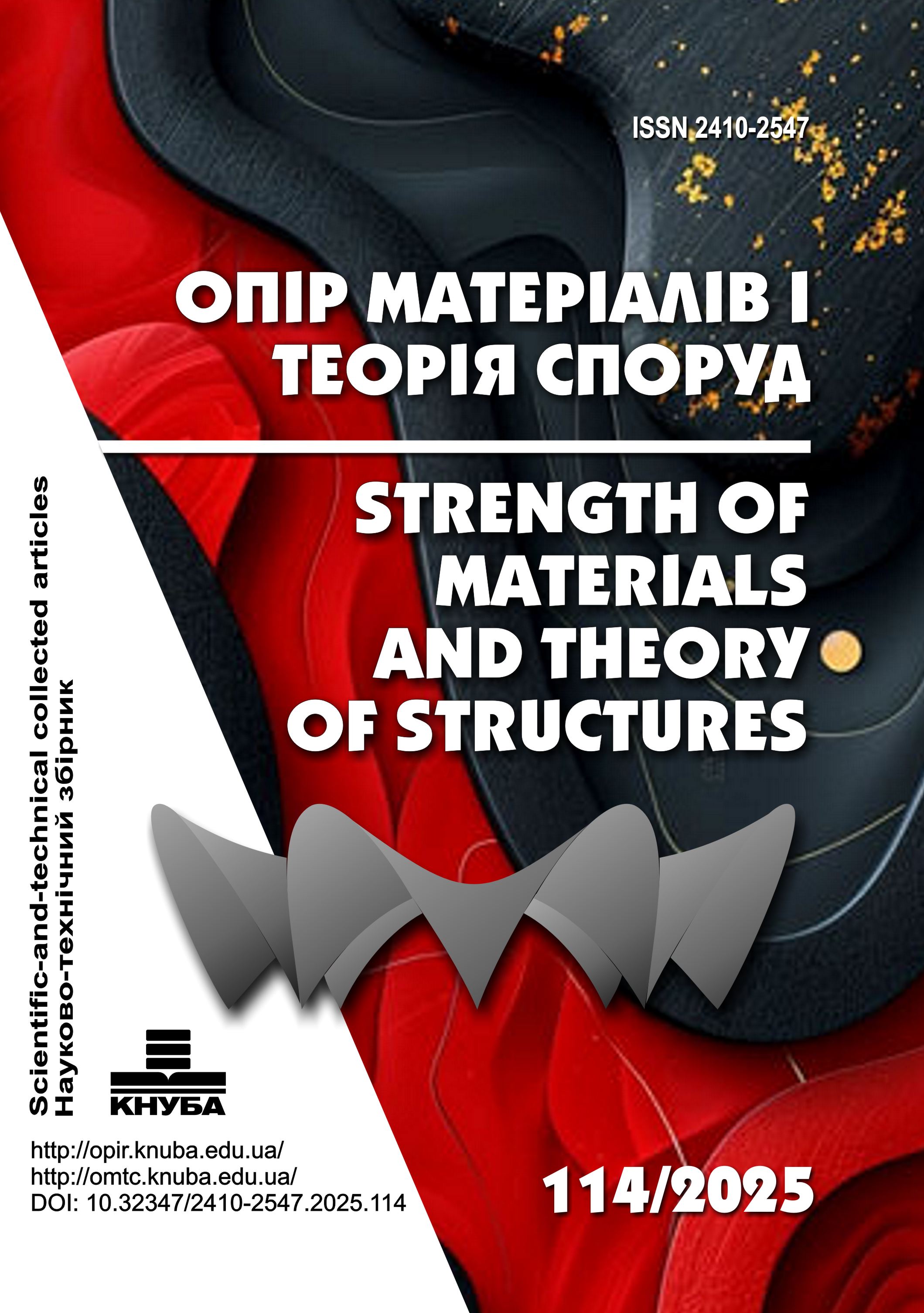Research of the design of a T-shaped node of cold-rolled profiles, the connection of which is made by a plate using a bolt connection
DOI:
https://doi.org/10.32347/2410-2547.2025.114.62-75Keywords:
finite element method, verification, equipment design, schemes-approaches-numerical modeling and calculation, conventional hinge joint, connectionAbstract
Warehouse complexes and premises used to accommodate storage equipment, move lifting equipment and personnel require the creation of modern load-bearing structures of mezzanines and platforms. Such structures must simultaneously meet the requirements of low metal consumption, sufficient strength, stability and withstand a large number of cycles of application and removal of loads. The nodes that connect the beams of such structures are designed as hinged. They allow the rotation of the beams and do not transmit bending moments from one element to the wall of another. The work proposes the design of a connection node(joint) that consists of a corner of a special design that is rigidly fixed to the walls of the profiles using a bolted connection. The peculiarity of the node is that it is conditionally hinged and ensures the absence of transmission of bending moments between the elements of the node. This is achieved due to the design of the corner, which has the necessary and sufficient flexibility (rotational plasticity)to compensate for the rotation of the ends of the connected beams due to its operation within the limits of plastic deformations at the plasticity limit of the material. On the other hand, the strength of this corner should be such that the transfer of loads between the structural elements occurs without its destruction. Numerical modeling of the design of the conditional hinged node was performed and the values of stresses in the elements included in the node were obtained. It has been confirmed that under working loads in all elements of the joint, except for the corner, the stresses do not exceed the plastic strain limit of the materials from which they are made, equivalent plastic deformations do not exceed the limit values (5%). The corner structure operates within the limits of plastic deformations and plays the role of a conventional hinge assembly. In certain zones of the corner structure, under working loads, stresses arise that exceed the limits of plastic strain limit of the material from which it is made. The destruction of the assembly does not occur. Such studies allow us to obtain detailed information about the magnitude of the stresses in all elements of the structures and to predict their behavior in real operating conditions, which ultimately provides the opportunity to develop modern structures with low metal consumption that are capable of operating throughout the entire service life without premature failure.
References
Bönisch, N., Schilling, J. C., &Mittelstedt, C. (2024). Stress fields at skin-stringer junctions in composite aircraft fuselages. International Journal of Mechanical Sciences, 284, 109737, DOI: https://doi.org/10.1016/j.ijmecsci.2024.109737
Pieczka, P., & Iwicki, P. (2024). Rotational stiffness of a connection made using a single prestressed bolt. Engineering Structures, 321, 118935, DOI: https://doi.org/10.1016/j.engstruct.2024.118935
Abbasi, M., Khezri, M., Rasmussen, K. J. R., &Schafer, B. W. (2018). Elastic buckling analysis of cold-formed steel built-up sections with discrete fasteners using the compound strip method. Thin-Walled Structures, 124, 58-71, DOI:http://dx.doi.org/10.1016/j.tws. 2017.11.046
Lyu, Y. F., Wang, Y. B., Li, G. Q., & Jiang, J. (2019). Numerical analysis on the ultimate bearing resistance of single-bolt connection with high strength steels. Journal of Constructional Steel Research, 153, 118-129, DOI:http://dx.doi.org/10.1016/j.jcsr.2018.10.006
Ye J, Quan G, Kyvelou P, Teh L, Gardner L. Ye, J., Quan, G., Kyvelou, P., Teh, L., &Gardner, L. (2022, April). A practical numerical model for thin-walled steel connections and built-up members. In Structures (Vol. 38, pp. 753-764). Elsevier, DOI:http://dx.doi.org/10.1016/j.istruc.2022.02.028
Hu, Y., Shen, L., Nie, S., Yang, B., &Sha, W. (2016). FE simulation and experimental tests of high-strength structural bolts under tension. Journal of Constructional Steel Research, 126, 174-186, DOI:http://dx.doi.org/10.1016/j.jcsr.2016.07.021
EN 1993-1-8:2005 Eurocode 3: Design of steel structures–Part 1–8: Design of joints. 2005
Quan, G., Ye, J., &Li, W. (2021, October). Computational modelling of Cold-formed steel lap joints with screw fasteners. In Structures (Vol. 33, pp. 230-245). Elsevier, DOI: https://doi.org/10.1016/j.istruc.2021.04.062
He, P., Wolters, M., Waltener, C., &Pavlovic, M. (2024). Debonding behavior of non-welded wrapped composite X-joints subjected to monotonic tensile load – Numerical study and validation. Engineering Structures, 321, 118969, DOI:https://doi.org/10.1016/j.engstruct.2024.118969
Pieczka, P., &Iwicki, P. (2021). Axial capacity of steel built-up battened columns. In Modern Trends in Research on Steel, Aluminium and Composite Structures (pp. 442-448). Routledge,DOI: http://dx.doi.org/10.1201/9781003132134-57
Falborski, T., Knabe, W., Perliński, A., & Urbańska-Galewska, E. (2019). Wybrane zagadnienia projektowania stalowych konstrukcji prętowych z wykorzystaniem programu Autodesk Robot Structural Analysis (pp. 1-150). Politechnika Gdańska.
Pieczka, P., &Iwicki, P. (2022). Numerical analysis on axial capacity of steel built-up battened columns. Archives of Civil Engineering, 68(2), DOI: http://dx.doi.org/10.24425/ace.2022.140665
Steel structures. Design standards. (2014).DBNV. 2.6 – 198: 2014. Кyiv: Minregionbud Ukraine[in Ukrainian].
Building and construction structures. Steel construction structures. Load testing methods. (1996). DSTUBV. 2.6-10:1996. Kyiv: UrkNDIproektstalkonstruktsiya [in Ukrainian].
EN 1991-1-1:2002 Eurocode 1: Actions on structures - Part 1-1: Generalactions - Densities, self-weight, imposedloadsforbuildings. 2002
Building steel profiles. (2020). Voestalpine Sadef. Retrieved December 18, 2024, from https://www.voestalpine.com/sadef/en/content/download/22620/file/Building%20brochure_sadef_2020_EN_WEB.pdf
Why is 5% plastic strain limit used in material diagram for EN? Idea StatiCa. Retrieved December24, 2024. URL: https://www.ideastatica.com/support-center/why-is-5-plastic-strain-limit-used-in-material-diagram-for-en
Downloads
Published
Issue
Section
License

This work is licensed under a Creative Commons Attribution 4.0 International License.
Authors retain copyright and grant the journal right of first publication with the work simultaneously licensed under a Creative Commons Attribution License that allows others to share the work with an acknowledgement of the work's authorship and initial publication in this journal.

